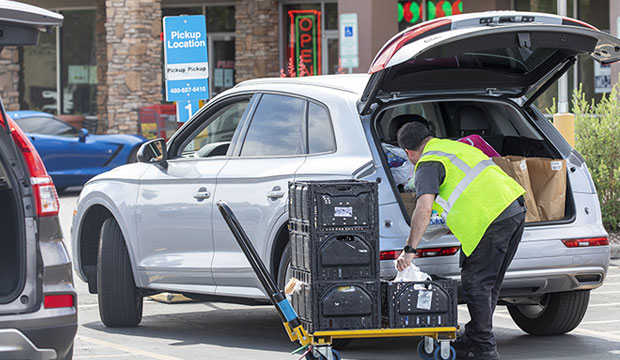As a result of the current pandemic-induced supply chain disruptions and evolving consumer shopping habits, a growing number of retailers are considering shuttering storefronts and selling their selected inventory with internet-based direct-to-consumer (DTC) buying options. A better option is for retailers to rethink their current business models and consider how to future-proof their operations.
Direct-to-consumer brands have become increasingly popular over the last several years. DTC merchants are seeing a digital marketplace primed for disruption as it feeds millennial and Gen Z consumers with a steady appetite for digital buying menus.
Closing physical storefronts in favor of DTC selling options is not necessarily the best approach for typical store owners, according to Mark Delaney, retail industry consultant at Zebra Technologies.
Large manufacturers, perhaps, can make a killing by bypassing the brick-and-mortar retail route. But retailers shuttering their stores and moving online solely is not a smart strategy for success, advised Delaney, who has more than 20 years in the industry working with most large retailers globally.
Adapting to DTC
Zebra builds tracking technology and retail solutions that generate actionable information and insight. This technology gives retailers new visibility into their businesses by giving tangible goods a digital voice.
However, not all retail brands transition easily from in-store shelves to digital displays offered Delaney. Native DTC brands have a competitive advantage since they were created for digital sales. Traditional retailers and consumer packaged goods (CPGs) brands face stiff challenges in transforming their business models and adapting to DTC constraints.
One of the biggest advantages that brick-and-mortar stores have is the ability for consumers to inspect products before buying them. Shoppers value seeing goods in person because it helps avoid inaccurate sizing, malfunctioning equipment, and product scams.
The E-Commerce Times engaged Mark Delaney in a wide-ranging conversation about today’s supply chain disruptions and evolving consumer shopping habits.
E-Commerce Times: Do you see DTC retailing as a bad strategy for floundering brick-and-mortar retailers?
Mark Delaney: Shopping for all sorts of things online is certainly something that a lot more consumers are trying. But it tends to be for some products that do not require shoppers to have hands-on quality inspections.
Take me, for example. About three years ago, my wife gave me a subscription to Harry’s [shaving products]. Since then, I haven’t even ventured down that aisle in a grocery store, or drugstore, Target, or what have you. That experience essentially took me out of the shopping mode for that particular category.
But the whole philosophy behind merchandising is based on foot traffic in-store. If I come in to buy milk and bread, I pass by the end caps in the front of the store and think of potato chips. I also pick up beer and something else.
That is how we operated for centuries. So shopping 100 percent online is very difficult. I am seeing most of the fulfillment still being done through the stores, even though it might be more efficient from an e-com perspective just shipping directly to the consumers.
Most of the retailers are leveraging their existing real estate to say, I just need to get better at fulfilling.
How does the shift to DTC retailing impact brick-and-mortar retailers?
Delaney: Looking at just grocery store retailers, pre-pandemic buying patterns showed e-commerce sales at about two percent. Now, for most retailers, depending on the retailer and the geography, that number can be as high as 20 or 30 percent.
No retailer, or very few retailers, had to develop a skill set around fulfillment from an e-commerce perspective. Now, all of a sudden, they are being forced to do it at a rate that is 10 or 15, or 20 times higher than what it was pre-pandemic.
How can retailers fix the fulfillment debacle?
Delaney: Retailers could introduce automation into the sort of transactional categories — boxed pasta, cereal, canned goods, things like that, things that you never enjoyed shopping for in the first place. Then figure out a way to automate what we call the center store. Next, take the experiential categories and really invest and build your brand based on those changes.
Certain retailers have built their reputations around what the in-store experience is to deflect customers from buying online. They modify to varying degrees their selection of organic and different types of produce, different cuts of meat, and things like that.
How successful is offering curbside pickup as a way to retain customers buying locally who have Covid health concerns?
Delaney: I was talking to a large grocery retailer two weeks ago, and he posed an interesting question or comment. He mentioned that he did not think he would be able to get anyone to get out of their car and come into the store to grab a cart, wrestle products onto the checkout belt, and then drag it out to their car. He had been doing that for them over the last 18 months for free.
That is a great point. Storefront retailers have to take all the transactional sort of work out of shopping for the consumer. Retailers must figure out a way to deliver those categories. Retailers can automate buying processes in some fashion. Then really invest in a different type of store of the future which is half distribution center. I think that is the winning strategy going forward.
What can in-store retailers do to work with their supply chain partners to improve fulfillment or open different fulfillment options?
Delaney: There is a lot to talk about regarding demand planning and demand sensing. This is a big area in today’s retail space. That is an area where retailers can work very closely with their partners around the supply chain.
Look at what is happening right now. Dozens, if not hundreds, of barges and ships are sitting off shipping ports that simply cannot get on the regular supply chain.
So we have to more effectively look and see and work with manufacturing partners to understand what that demand is going to be over the course of time. That is how retailers can make sure that, at the end of the day, they are satisfying the customer.
The worst thing customers see when they go into a store is the products they want being out of stock. Customers then feel defeated even though they took a risk being there during a global pandemic.
It sounds like retailers need to think more about the essentials for future proofing their retail business.
Delaney: Absolutely. Everyone has gone through a lot of new processes almost overnight. Whether plexiglass or touchless, or sanitation, or curbside delivery. Temporary remedies got thrown together. As we are starting to emerge, retailers sort of are taking a deep breath and saying, we need to figure out how to do this better.
That is where Zebra Technologies is heavily engaged with our customers right now. We are trying to figure out what the supply chain looks like for 2025 or 2030. What does the store of the future look like?
What are the absolute must-have technologies needed for retailers to future-proof their stores?
Delaney: First, retailers must get off pen and paper and join the digital evolution to modernize their way of doing business.
Second, retailers have to make sure that every associate is both visible and optimally utilized to best serve in-store customers. We firmly believe that all those associates need to have some sort of technology.
Third, retailers must not forget they are competing against a growing arsenal of online competition. They have to use technology for better efficiency. Retail managers should have their employees on a network in the store. Know where they are and what they are doing. Have various task management applications for an idea of how to do things effectively and how to measure one associate versus another. Know which ones need additional training.
How else can retailers be future-proof?
Delaney: For the retailers that are ready for it, we are having a lot of conversations about automation. Automation could be as simple as mobile computers tied to data analytics. It could go as far as automating warehouses and back rooms for fulfillment.
Even doing something as simple as buy-online-pickup-in-store to make money is something that most retailers still can’t make work. It is just inefficiencies in the way they are doing it. Retailers have not cracked the code yet for how they can quickly pick and pack these orders.
It involves a lot of labor, and labor is getting more expensive and scarcer every day. That is not going to go away anytime soon. So it is forcing retailers to finally look at varying degrees of automation. To some retailers, automation might be as basic as moving away from pen and paper to a mobile computer; to others, that might mean installing a micro fulfillment center on the back of the store.
Is offering local buyers home delivery a way for brick-and-mortar shops to compete with online buying?
Delaney: The last mile between store and customer has always been the biggest struggle. The last mile varies by where you live. Most retailers want you in the store or, at the very least, want you to pull up for curbside delivery. Home delivery is by far the most expensive to provide.




























































Social Media
See all Social Media